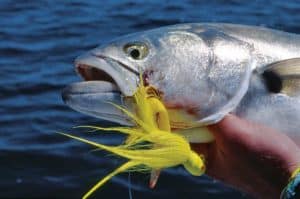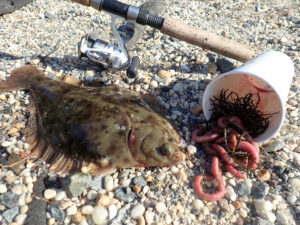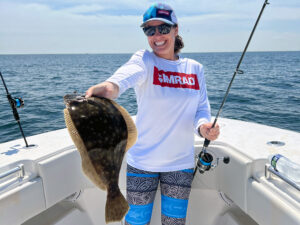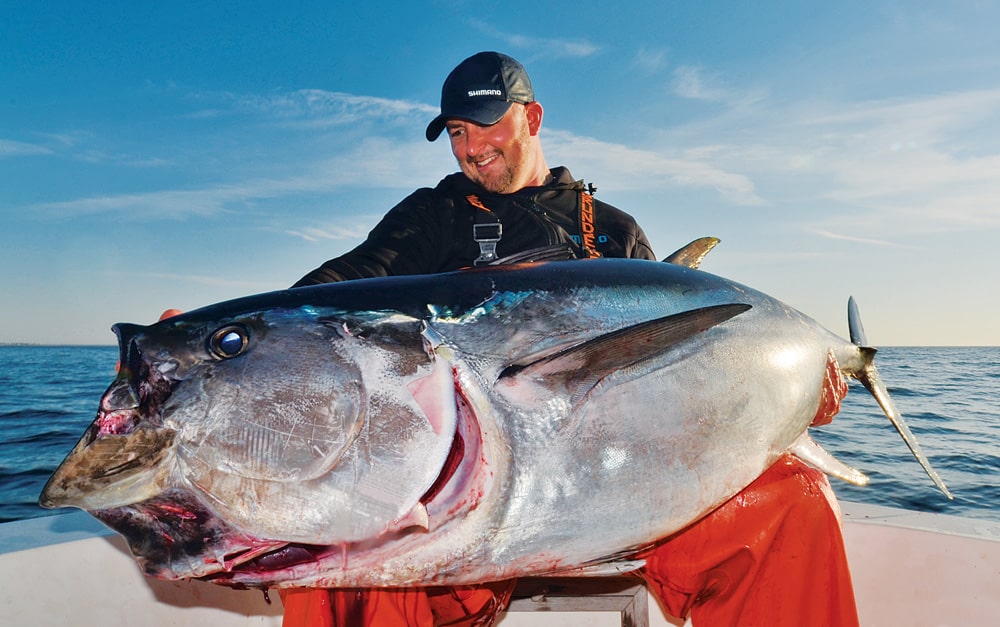
We really should thank tuna. Yellowfin, bluefin, albacore and bigeye travel distances that make marathon runners look pedestrian. Because of that, they always have to eat.
September to November, anglers target the Atlantic species along offshore canyons that make up the Eastern Seaboard’s continental shelf.
May through July, southern bluefin and yellowfin feed aggressively off Australia’s southeastern coast over current-swept seamounts, says Al McGlashan, an Australian fishing TV host out of Sydney, and contributor to Sport Fishing.
Fortunately, the same tactics — chumming, or chunking — dupe them no matter their location. I talked with three highly regarded anglers from Rhode Island, New Jersey and southern Australia to learn their top chunking techniques for tuna.
Prep Pays
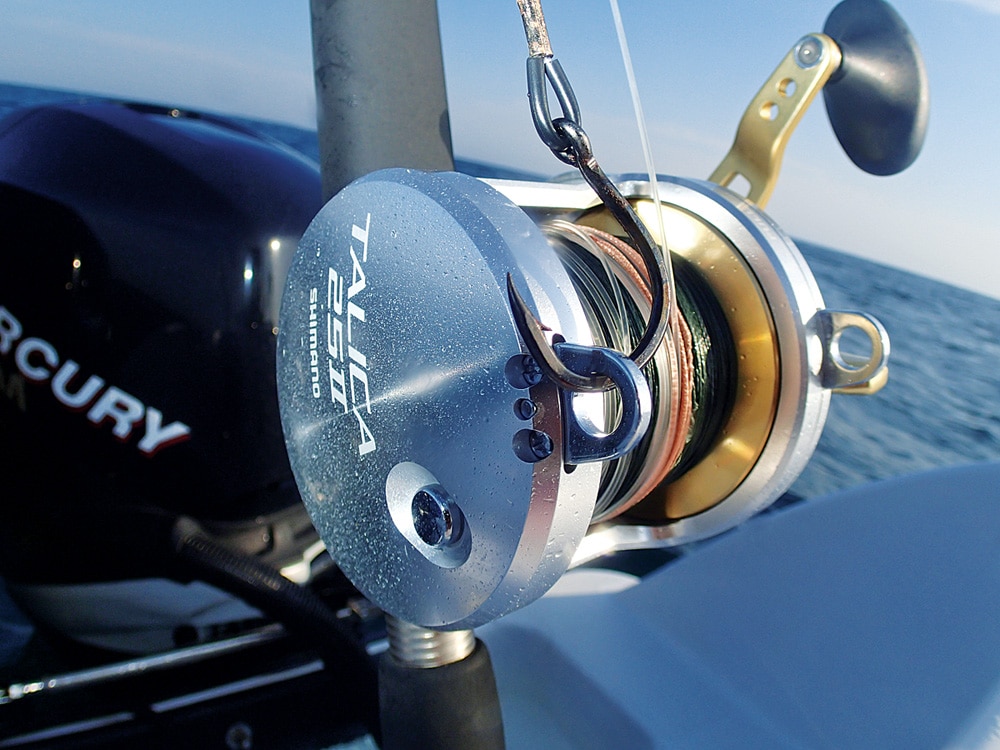
Before these expert tuna-chunkers even leave the dock, significant efforts are put into preparation.
“The day before a trip, we start to prep,” says Capt. Dave Bender, a New Jersey canyon fisherman. “We’ll load up to six flats of butterfish [for chum baits], 1,000 pounds of ice into five giant coolers, and tackle rigs made the night before.”
Chunkers pay special attention to ocean forecasts, sea surface temperature maps and chlorophyll charts before ever getting to the dock. Sites like roffs.com, buoyweather.com, and oceantemp.com offer valuable forecasting and up-to-date conditions.
“We’re looking for eddies that spin off west from the Gulf Stream, toward the continental shelf — that’s what holds the tuna,” says Bender. “The chlorophyll charts are used to help find clear blue water and signs of life; higher concentrations of chlorophyll mean more baitfish.”
The best depths to fish range along the 600- to 1,000-foot drops that form areas such as Wilmington, Baltimore and Hudson canyons, says Bender.
“Some of these areas became popular back in the day because lobster gear marked the same areas,” explains Bender. “Even back then it was illegal, but boats would tie up to the gear, using it as an anchor.”
Bender ports out of Brielle, New Jersey. That’s a 76- to 112-mile shot — he has to maximize fish-catching potential while he’s out there.
“One mistake I see made all the time is drifting out into 3,000 and 4,000 feet of water,” he says. “The tuna gather near the bait, and the bait’s at the structure.”
In other words, don’t fall off the shelf.
If You Chum, They Will Come
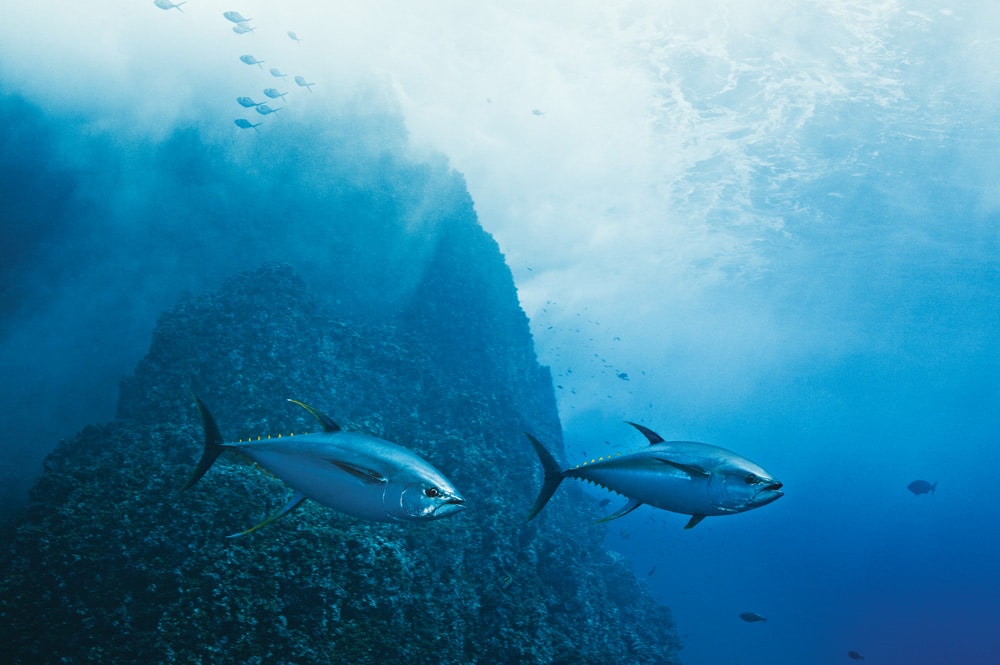
The long run itself is reason enough to stay the night and fish — it’s also the time when tuna respond to chumming the most successfully.
During the last daylight hours, Capt. Jack Sprengel, of Point Judith, Rhode Island, looks for birds such as shearwaters, which rely on predators to push baitfish to the surface. He’ll also mark squid and baitfish in the top 200 feet of the water column on his depth finder.
Fishing southeastern Australia, Al McGlashan marks tuna on his sounder.
“We set the sounder to read the top 60 fathoms when chunking. More often than not, we’ll pick up the tuna sitting down below the thermocline. Then they’ll come up the chum trail.”
Once you’ve found tuna, both drifting and anchoring at night work. Bender brings 1,800 feet of anchor line (plus 600 feet of backup) to stay in one place while he’s chunking.
Sprengel chunks fresh mackerel or herring while he’s drifting.
“We will ‘blast’ a five-gallon bucket of chum out when the fish start to show,” says Sprengel. “Once we recognize the direction of the drift, we’ll cover 2 miles, then run back and start the drift over. Don’t go 40 minutes without a bite.”
Sprengel cuts the chum into 1-inch pieces. The best herring baitfish — the choice baits — are saved for hooked baits. He slits the belly, threads the line through the mouth and out the stomach, then ties on a live-bait hook. He leaves some hook exposed, and stitches the belly and mouth shut to stop unwanted spin in the water.
Another critical factor to keep baitfish, squid and tuna surrounding the boat at night calls for deploying an underwater light. Sprengel keeps his Hydro Glow on the boat side facing up-sea so nothing slips underneath the boat while drifting.
Game On
And the fish that do show can be massive.
Yellowfin tuna in Australia in summer run 55 to 220 pounds, says McGlashan. Bluefin range from 100 to 330 pounds.
Off the Atlantic Seaboard, expect longfin (albacore) to run 25 to 50 pounds in fall. Yellowfin weigh up to 80 pounds regularly. Bluefin nearshore average 25 to 80 pounds, but the large “nomadic” bluefin offshore surpass 200 pounds up to true giants.
For tackle, Sprengel favors Shimano Terez rods with Talica 25 II two-speed reels.
“You can use lighter, but we actually use these for trolling, chunking and jigging,” he says. “This reduces the number of setups we need to bring offshore.”
He spools up with 80-pound PowerPro Hollow Ace and ties a spider hitch in the terminal end of his main line. Then he attaches a working leader. At the bitter end, tie on a No. 3 Spro in-line swivel, then about 10 feet of fluorocarbon leader testing 60 to 80 pounds. Sprengel uses 6/0 to 10/0 Gamakatsu HD live-bait hooks, depending on the fish size.
Capt. Dave Bender keeps one flat line rigged with a sardine and no weight about 100 yards out. That one usually gets bit first. Another rod is outfitted with a balloon about 40 feet out, rigged with an 8- to 20-ounce egg sinker, depending on the current. Three other lines cover the water column, set at 60, 80 and 100 feet of water.
In total, anglers have shots at a wealth of tunas, plus swordfish and billfish. Sprengel prefers his home waters to all others in fall, as he’s not afraid to tell you. Plus, there’s one fish that all tuna fishermen dream of in this neck of the woods: the bigeye tuna. Anglers tell stories of monsters they couldn’t stop in the dead of night — they could have been bigeyes.
“Bigeyes are the most powerful fish out there,” says Sprengel. “They usually hit during the early morning or late evening. Anyone who brings one back to the dock deserves respect.” There’s nothing like a power workout from one of the best-tasting fish in salt. Thanks, tuna!

